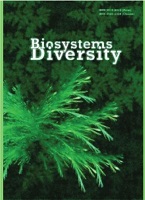Diversity of diversity indices: Which diversity measure is better?
Diversity of diversity indices: Which diversity measure is better?
Author(s): O. M. Kunakh, A. M. Volkova, G. F. Tutova, O. V. ZhukovSubject(s): Methodology and research technology, Policy, planning, forecast and speculation, Rural and urban sociology, Environmental interactions
Published by: Дніпропетровський національний університет імені Олеся Гончара
Keywords: species richness;Shannon index; evolution;succession;urban park;recultivation; ecosystem comparison;
Summary/Abstract: The article evaluates the dependence of the most common indices of species diversity on sample size and determines their ability to differentiate between different types of ecosystems, with a special emphasis on discriminating between natural and anthropogenic ecosystems. An approach to adjusting the indices to reduce their dependence on sample size was also proposed. The study was conducted in seven types of ecosystems: four were natural and three were anthropogenically transformed. Samples of soil animals were selected in 2011–2013 and 2021 using the same methods. A total of 20,518 soil animal specimens belonging to 202 species were collected in all study locations. The null alternative was generated by randomly selecting samples containing 2, 3, ..., 110 soil animals from the combined soil animal sample. For each gradation of sample size, 200 sample variants were formed. The density of soil macrofauna in natural ecosystems ranged from 3.6 ± 1.5 to 15.2 ± 6.9 specimens per sample, and in artificial ecosystems – from 13.2 ± 7.6 to 21.0 ± 11.9 specimens per sample. The number of species ranged from 22–80 species, and in artificial ecosystems it was 38– 99 species. Indicators of species diversity correlated with each other. A high level of correlation was observed between indicators within groups of indices: indices of species richness and indices of heterogeneity and evenness. Fisher’s log-series alpha and the fundamental parameter of biodiversity were highly correlated with each other, as well as with the Margalef, species richness, and Chao’s species abundance indices. The log-normal distribution best describes the dominance patterns in terms of abundance in the natural ecosystems, and the Zipf-Mandelbrot distribution best describes the dominance patterns in terms of abundance in the artificial ecosystems. Diversity indices were ordered in the space of two dimensions, one explaining the variation between ecosystems and the other depending on sample size. The ordering of the traditional indices showed that there is a vacancy for the best index in the sense that such an index should best explain differences between ecosystems and differences between natural and artificial ecosystems. Itshould also be independent of sample size. The Simpson heterogeneity index and the Simpson evenness index were the best of the traditional indices, but they did not explain differences between ecosystems very well, especially when it came to distinguishing between natural and artificial ecosystems. The Margalef index, which is supposed to be independent of sample size, on the other hand, showed a very high level of dependence. Such a dependence was also found for the Menhinick index, though to a lesser extent. Obviously, size dependence negatively affects the differential ability of the indices. The corrected indices of species richness and the Shannon index are practically independent of sample size and have a greater ability to differentiate ecosystems by the level of diversity, with natural ecosystems characterized by consistently higher values of the corrected indices than artificial ecosystems. The dependence on the sample size makes indices from different ecosystems practically incomparable, which makes their use meaningless. Even minor differences in sample size can lead to significant deviations in the values of diversity indices. The application of the Michaelis-Menten model allowed us to suggest a method of correction of species richness indices and the Shannon index. After the correction, the indices are practically independent of the sample size, and their differential ability to characterize individual ecosystems and the level of anthropogenic transformation increases significantly.
Journal: Biosystems Diversity
- Issue Year: 31/2023
- Issue No: 2
- Page Range: 131-146
- Page Count: 16
- Language: English

